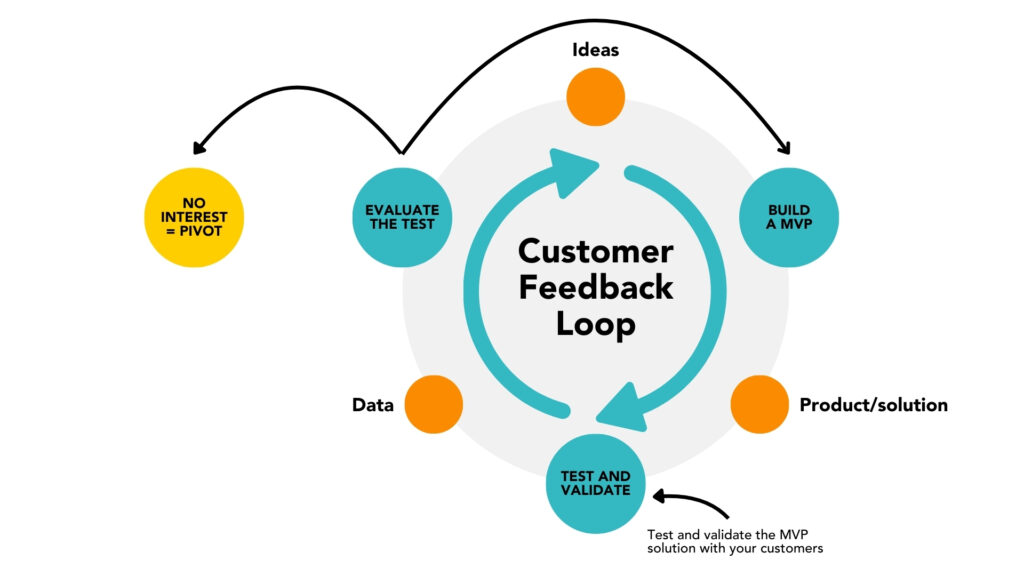Zappos success story
Zappos, the online shoe and clothing retailer, is a prime example of doing things differently, offering the same products.
In 1999, Nick Swinmurn, the founder of Zappos, had an idea to create an online store that offered a wide selection of shoes and provided a convenient and enjoyable shopping experience for customers. He believed that selling shoes online could be a successful venture despite the conventional wisdom at the time suggesting that customers would prefer to try on shoes in physical stores.
To test his hypothesis, Nick decided to use Eric Ries’s BML model.
“Build, Measure, Learn” (BML) is a fundamental concept in the Lean Startup methodology, popularized by Eric Ries. It represents a cyclical process of iterative product development and validation.

The build phase
In the Build phase the aim is to build a minimum viable product (MVP), the simplest version of your product that allows you to test your assumptions and hypotheses. The emphasis is on speed and efficiency in getting something functional into the hands of users to gain feedback and validation.
Nick Swinmurn began by building the initial version of the Zappos website. At this stage, he created a simple Minimum Viable Product (MVP) that showcased a limited selection of shoes with basic product information and a simple online shopping process with free shipping. For it to really be an MVP, Nick went to the local shoe store and took photos of some shoe models. Put them on the site, and when a customer’s order came, he went and bought the shoe at the local shoe store. In this way, he could test whether customers wanted to buy shoes online without the risk of inventory. The MVP allowed customers to browse and order shoes online.
The measure phase
Once the MVP is out in the wild, gathering data on how users interact with it is key. This could include metrics like user engagement, retention, and conversion rates, etc. The goal is to collect meaningful data that gives insight into how users respond to the product.
With the MVP in place, Swinmurn closely monitored user interactions and collected valuable data on customer behaviour. He tracked metrics like website traffic, conversion rates, customer feedback, and purchase patterns to understand how users were responding to the concept.
The learn phase
In this phase, it is time to analyse the data collected during the measurement phase and draw insights from it. This could involve identifying areas where the product excels, uncovering pain points or areas for improvement, and validating or invalidating assumptions about user behaviour. Based on the learnings, iterations of the product or service can be made by making changes or adjustments and then starting the cycle again to validate what features customers want and are willing to pay for. The Build-Measure-Learn loop is iterative, meaning that each cycle builds on the insights gained from the previous one, leading to continuous improvement and refinement of the product or service. The ultimate aim is of course to create a product that not only meets the needs of users but also has a sustainable and scalable business model.
The data and feedback from early customers provided essential insights into how the business could be improved for Swinmurn. He discovered that, contrary to expectations, customers were willing to buy shoes online without trying them on first. This key learning challenged the prevailing assumption and demonstrated the potential demand for an online shoe store.
The decision phase
Armed with the data gained from the BML loop, Swinmurn made a strategic decision to focus solely on selling shoes online. He was convinced that the demand was there, and he saw an opportunity to address customers’ pain points, such as limited selections and long wait times at physical stores.
“Ideas are a commodity. Execution of them is not.”
– Nick Swinmurn, founder of Zappos
The constant improvement phase
This phase can also be called the investment Phase. When there is proof of concept, you can make wise, low-risk investments that have a potentially high and fast return on investment.
Zappos continued to iterate and improve its online shopping experience based on customer feedback and data analysis. The company expanded its product range, enhanced customer service, and streamlined the checkout process. These constant improvements cemented Zappos’ reputation for excellent customer service and satisfaction.
Due to its commitment to the BML loop and customer-centric approach, Zappos grew rapidly and became a leading online retailer in the shoe and clothing industry. The company’s success is a testament to the power of data-driven decision-making, the willingness to adapt and learn, and the relentless focus on customer needs and preferences.
“Customer service shouldn’t just be a department; it should be the entire company.”
– Tony Hsieh, the late CEO of Zappos
From $0 to $1.2 billion in 10 years
In 2009, Zappos was acquired by Amazon for approximately $1.2 billion, further solidifying its position as a prominent player in e-commerce. Zappos’s story serves as an inspiring example of how applying the Build-Measure-Learn loop can transform an idea into a successful, customer-centric business.
Key takeaways
What can you learn from this story?
Leaders need to think big, start small and validate before they invest. In a disruptive world like today where things change fast, testing ideas with the market is more crucial than ever before. Using an iterative approach to deliver value in small batches using the MVP concept and BML Model can help you accelerate your understanding of what can accelerate your growth. Zappos understood the value of customer feedback and making decisions based on customer interactions. They understood the value of measuring and analyzing customers’ actions and constantly improving their products and services to accelerate their business.
If you are willing to do the same you can make wiser investment at the same time as delivering value faster to your customers and adapting when needed to avoid investments in features that customers do not value. I like how this relates to the willingness to serve the customer with the understanding that there is only one boss and she can fire everyone from the chairman down simply by spending her money elsewhere, as inspired by Sam Walton, Founder of Walmart and Sam’s Club’s famous quote.
- Use MVPs to test ideas.
- Focus on customer feedback
- Making data-driven decisions
- Continuously improve for scalable success.
Zappos exemplifies how applying the BML loop can transform an idea into a thriving business.
Do you want to make wiser decisions, smarter investments and gain higher and faster return on your investments?


